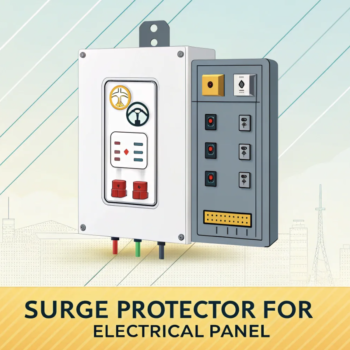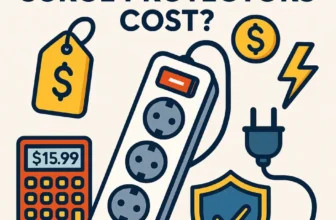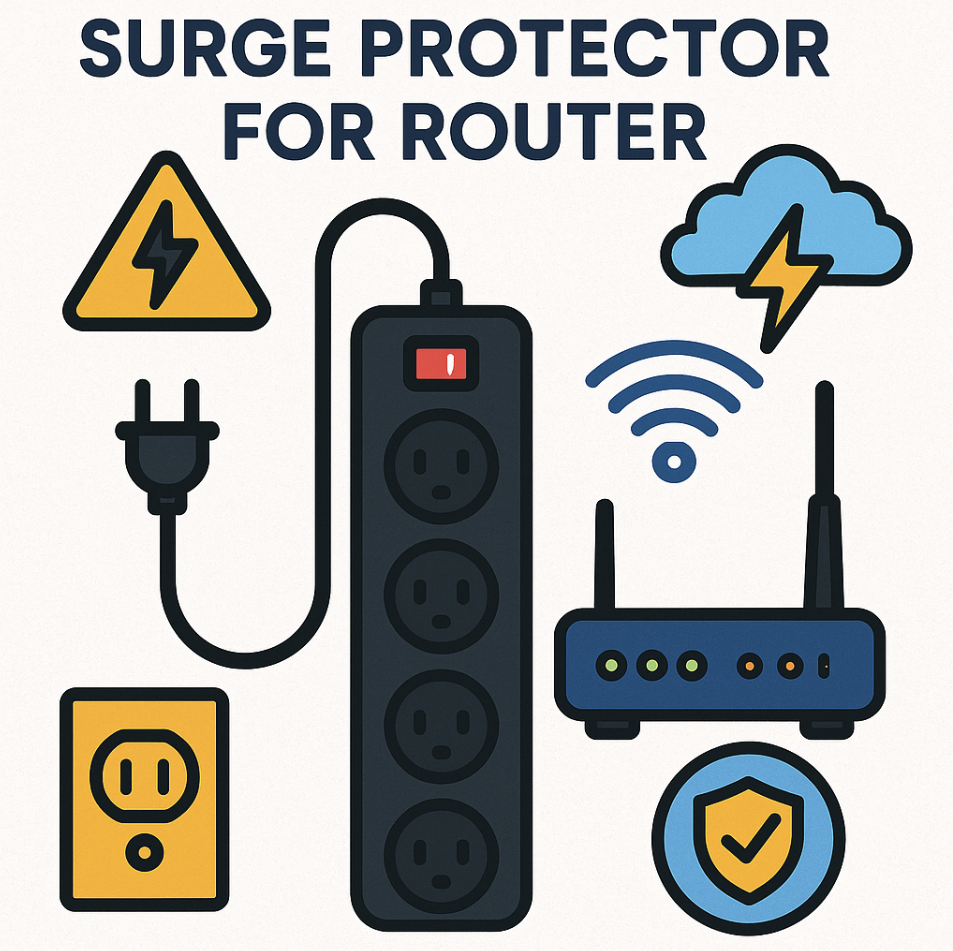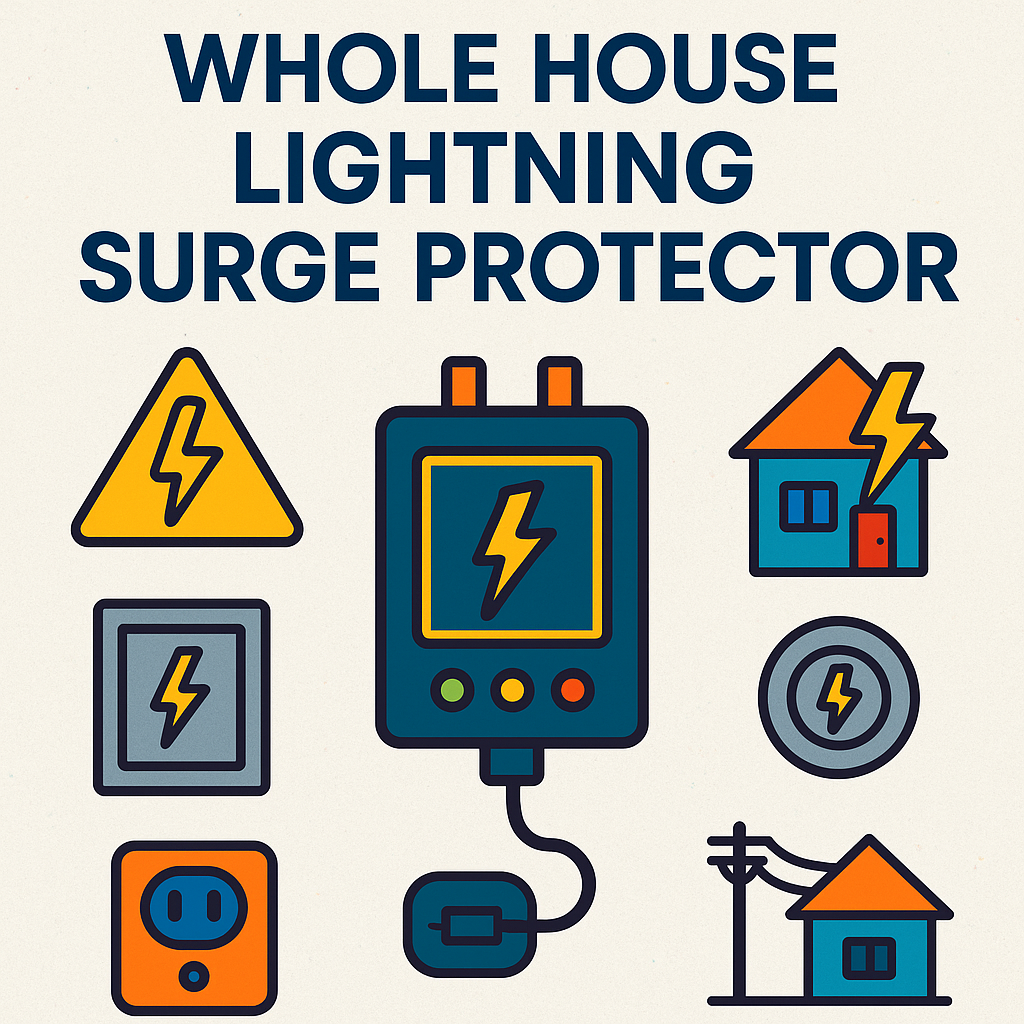Published By: Sean Hudson | Last updated on April 21, 2025 and reviewed by Editorial Team
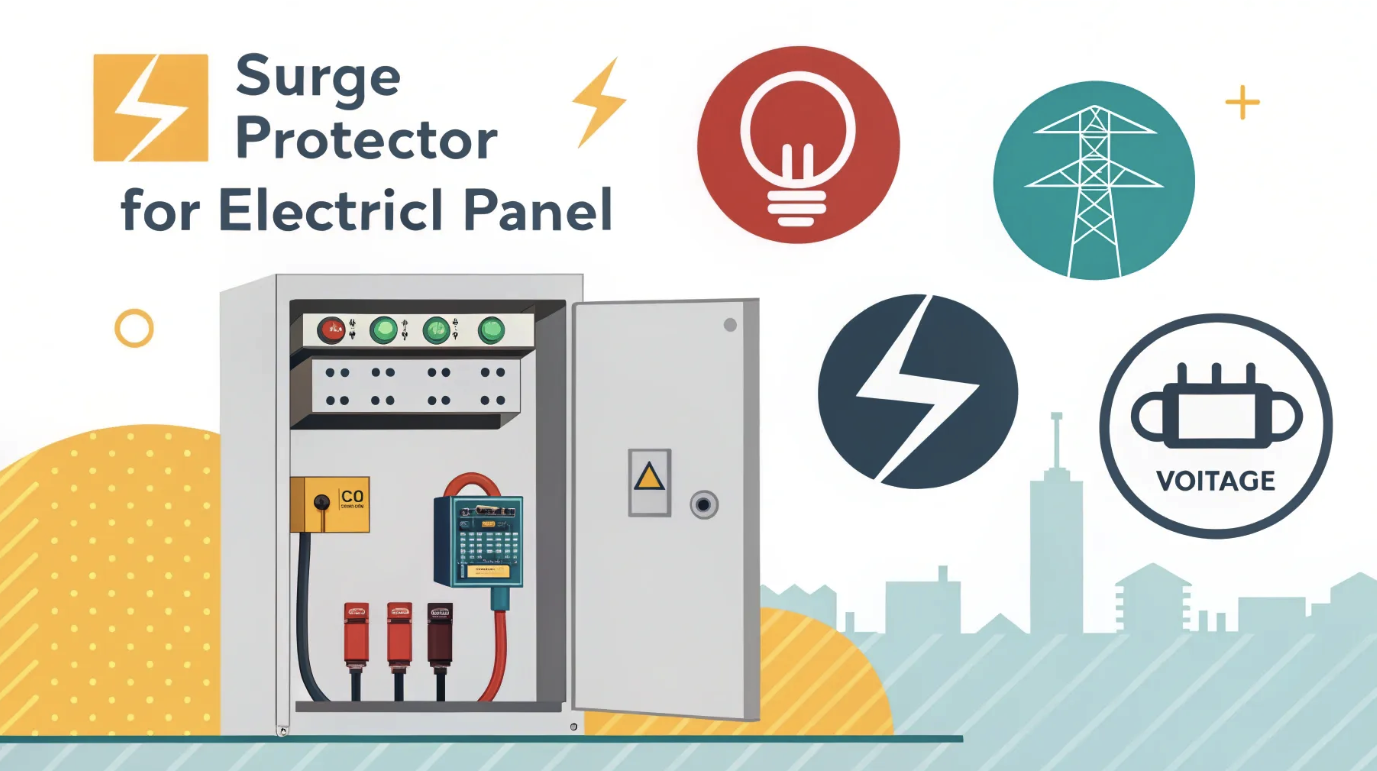
As a home owner, are you aware that a sudden power surge could fry your expensive electronics? Scary, right? Power surges can wreak havoc on your home, damaging everything from computers to big-screen TVs. They can even start fires. That’s why choosing the right surge protector for your electrical panel is crucial. You need a reliable shield against these unpredictable spikes.
A surge protector for electrical panel acts like a guardian, intercepting dangerous voltage before it harms your devices. It’s not just about protection; it’s about peace of mind. So, how do you pick the right one? Read on to find out.
Understanding Power Surges
Have you ever wondered why your lights flicker during a storm or why your computer suddenly shuts down? These are often signs of a power surge. Understanding what causes these surges and their impact on your home’s electrical system can help you protect your valuable electronics.
What Causes Power Surges?
A power surge is a sudden increase in voltage that can damage your electrical system. Several factors can trigger these surges:
-
Lightning: One of the most common causes of a major power surge. When lightning strikes near a power line, it can send a massive amount of electricity into your home, overwhelming your electrical system.
-
Power Grid Switching: Utility companies sometimes switch power grids to manage electricity demand. This process can lead to brief voltage increases, resulting in a power surge.
-
Electrical Overloads: Plugging too many devices into a single outlet can cause an overload, leading to a power surge. This is especially true for high-power appliances like air conditioners and refrigerators.
-
Faulty Wiring: Poor or outdated wiring can cause power spikes. If your home has old wiring, it might not handle the electrical load, leading to frequent surges.
Impact of Power Surges on Your Home’s Electrical System
The effects of a power surge on your electrical system can be severe. Here’s how they can impact your home:
-
Damage to Electronics: A major surge can fry the circuits in your electronics, rendering them useless. Sensitive equipment like computers and TVs are particularly vulnerable.
-
Data Loss: Surges can corrupt data on your devices. Imagine losing important files or cherished photos because of a sudden power spike.
-
Fire Hazards: In extreme cases, a major power surge can cause wires to overheat, leading to fires. This risk underscores the importance of having proper surge protection.
-
System Failures: Frequent surges can weaken your electrical system over time, leading to failures and costly repairs.
Understanding how surge protectors work can help mitigate these risks. They act as a barrier, absorbing excess voltage and preventing it from reaching your devices. Investing in a good surge protector is not just about protecting your gadgets; it’s about safeguarding your home and ensuring peace of mind.
Types of Surge Protectors
Choosing the right surge protector can feel overwhelming with so many options available. But understanding the different types can make your decision easier. Let’s break down the three main types of surge protectors and see how they can safeguard your home.
Type 1 Surge Protectors
Installation and Functionality
Type 1 surge protectors are your home’s first line of defense against external power surges. You install them directly on the line side of your main electrical service entrance. This means they intercept surges before they enter your home’s wiring system. They work by diverting excess current to the ground, protecting your entire electrical system from damage.
Ideal Use Cases
These protectors are perfect for areas prone to lightning strikes or frequent power grid switching. A Type 1 surge protector can offer peace of mind if you live in a region with unpredictable weather. They provide comprehensive protection for all your home appliances and electronics.
Type 2 Surge Protectors
Installation and Functionality
Type 2 surge protectors are installed at the service entrance or subpanels. They protect against internal surges caused by devices within your home. These protectors use metal oxide varistors (MOV) to limit voltage spikes, ensuring that only safe current reaches your devices. They also connect to the ground wire, which helps in safely dissipating excess energy.
Ideal Use Cases
Ideal for homes with multiple high-power appliances, Type 2 protectors shield your electronics from surges generated by devices like air conditioners and refrigerators. They are essential for maintaining the longevity of your sensitive electronics.
Type 3 Surge Protectors
Installation and Functionality
Type 3 surge protectors are point-of-use devices. You plug them directly into outlets, and they protect individual devices. They are the last line of defense, catching any surges that Type 1 and Type 2 protectors might miss. These protectors often come with additional features like USB ports for charging.
Ideal Use Cases
Use Type 3 protectors for specific devices like computers, televisions, and gaming consoles. They are perfect for protecting valuable electronics that are sensitive to even minor surges.
Here’s a quick comparison table to help you decide which type suits your needs best:
|
Type |
Installation Location |
Protection Level |
Ideal For |
|---|---|---|---|
|
Type 1 |
Main Service Entrance |
Whole House |
Lightning-prone areas |
|
Type 2 |
Service Entrance/Subpanels |
Internal Surges |
Homes with high-power appliances |
|
Type 3 |
Individual Outlets |
Specific Devices |
Sensitive electronics |
Understanding these types helps you choose the right surge protector for your home; each type helps safeguard your electronics from unexpected voltage spikes. Remember, investing in the right surge protector is not just about protecting your gadgets; it’s about ensuring the safety and longevity of your home’s electrical system.
Core Features to Have
Choosing the right surge protector for your home isn’t just about picking any device off the shelf. You need to consider several core features that ensure your protector can handle the demands of your electrical system.
Let’s explore these essential features.
Power Handling Capabilities
Power handling capabilities are crucial when it comes to surge protectors. You want a protector that can absorb large surges without failing. Look for a high joule rating, which indicates the amount of energy the protector can handle before it stops working. A higher joule rating means better protection for your devices. For instance, a protector with a 2000-joule rating can handle more power than one with a 1000-joule rating.
This feature is useful if you have expensive electronics or live in an area prone to frequent power surges.
Response Time
Response time is another critical feature. It refers to how quickly the protector can react to a power surge. The faster the response time, the better the protection for your devices. Ideally, you want a protector with less than one nanosecond response time. This quick reaction ensures that your electronics are shielded from sudden voltage spikes.
Do remember that even a slight delay can result in damage to your sensitive equipment.
Durability and Longevity
Durability and longevity are essential when selecting a surge protector. You want a device that will last and provide reliable protection over time. Look for protectors made from high-quality materials that can withstand wear and tear.
Do also consider the warranty offered by the manufacturer. A longer warranty period often indicates a more durable product. Regularly inspect your protector for signs of wear, such as discoloration or corrosion, to ensure it remains effective.
Here’s a quick comparison table to help you understand these features better:
|
Feature |
Importance |
Ideal Specification |
|---|---|---|
|
Power Handling |
Absorbs large surges |
High joule rating (2000+) |
|
Response Time |
Quick reaction to surges |
Less than 1 nanosecond |
|
Durability & Longevity |
Long-lasting protection |
High-quality materials, long warranty |
Investing in a quality surge protector with these core features is a wise decision. It not only protects your valuable electronics but also extends their lifespan. Remember, while no protector can guarantee 100% protection against all power disturbances, choosing the right one significantly reduces the risk of damage. Prioritize these features to ensure your home is well-protected against unexpected power surges.
Key Specifications
Understanding key specifications can make all the difference when you’re on the hunt for the perfect surge protector. These specs determine how well a whole-home surge protector can handle unexpected voltage spikes and keep your electronics safe.
Let’s get into two crucial specifications: Voltage Protection Rating and Energy Absorption Rating.
Voltage Protection Rating
Think of the Voltage Protection Rating (VPR) as the surge protector’s shield strength. It tells you the maximum voltage the protector will let through to your devices during a surge. A lower VPR means better protection for your electronics.
You want a surge protector that keeps this number as low as possible, ensuring minimal voltage reaches your gadgets.
A VPR of 600 volts or less is ideal for whole-home surge protectors. This rating ensures that your sensitive electronics remain unharmed even during a significant power surge. When evaluating different models, always check the VPR to ensure you’re getting the best defense for your home.
Energy Absorption Rating
The Energy Absorption Rating, often measured in joules, indicates how much energy a surge protector can handle before it fails. Think of it as the protector’s stamina. The higher the joule rating, the more energy it can absorb, offering better protection against multiple surges.
Aim for a joule rating of at least 2000 for a whole-home surge protector. This level of protection ensures that your surge protector can handle several large surges over time without compromising its effectiveness. Remember, higher joule ratings offer better protection against power surges, making them a crucial factor in your decision-making process.
Here’s a quick comparison table to help you understand these specifications better:
|
Specification |
Importance |
Ideal Value |
|---|---|---|
|
Voltage Protection Rating |
Limits voltage reaching devices |
600 volts or less |
|
Energy Absorption Rating |
Absorbs energy from surges |
2000 joules or more |
Choosing a whole-home surge protector with the right specifications is essential for safeguarding your electronics. By focusing on these key specs, you ensure that your home remains protected against unexpected power surges.
Remember, investing in a quality surge protector is not just about protecting your gadgets; it’s about ensuring the safety and longevity of your home’s electrical system.
Factors to Consider When Choosing a Surge Protector
Choosing the right surge protector for your electrical panel can feel like navigating a maze. You want to ensure your home and devices are safe from unexpected power surges. Let’s break down the essential factors you should consider to make an informed decision.
Compatibility with Electrical Panel
First things first, you need to ensure that the surge protector is compatible with your electrical panel. Not all surge protectors fit every panel, so checking the specifications is crucial. Look for a surge protector that matches the voltage and current ratings of your panel. This ensures that the device can handle the electricity load without causing any issues.
Compatibility is key to maintaining a safe and efficient electrical system in your home.
Installation Requirements
Next, consider the installation requirements. Some surge protectors are easy to install, while others might require professional help. If you’re uncomfortable working with electricity, hiring a licensed electrician is best. They can ensure that the surge protector is installed correctly and safely.
Proper installation is vital for the surge protector to function effectively and provide the necessary protection for your electrical system.
Budget Considerations
Finally, think about your budget. Surge protectors come in a wide range of prices, from affordable options to high-end models. While it might be tempting to go for the cheapest option, remember that quality matters. Investing in a reliable surge protector can save you money in the long run by preventing damage to your electronics.
Consider the features and specifications you need, and choose a surge protector that offers the best value for your money.
Here’s a quick comparison table to help you evaluate these factors:
|
Factor |
Importance |
Considerations |
|---|---|---|
|
Compatibility |
Ensures proper fit with electrical panel |
Match voltage and current ratings |
|
Installation Requirements |
Safe and effective installation |
Professional help if needed |
|
Budget |
Balances cost with quality |
Invest in reliable protection |
Focus on these factors to choose a surge protector that meets your needs and provides peace of mind. Protecting your home’s electrical system is an investment in safety and longevity. Select a surge protector that fits your requirements and budget.
Check Buyers’ Opinions, Feedback, and Reviews
When you’re on the hunt for the perfect surge protector, diving into customer reviews can feel like a treasure hunt. You want to find that golden nugget of information that assures you of your choice. But why are these reviews so crucial?
Importance of Customer Reviews
Customer reviews offer a window into real-world experiences. They provide insights that product descriptions often miss. When you read reviews, you get a sense of how the surge protector performs in everyday situations. For instance, did it protect someone’s expensive home theater system during a storm? Or did it fail when faced with a minor power surge?
Survey Results:
-
82% of surveyed professionals emphasize the necessity of surge protection for safeguarding expensive equipment. This statistic highlights the importance of choosing a reliable surge protector.
Reviews also reveal potential issues. If multiple users mention a common problem, it’s a red flag. You can avoid products that might not meet your expectations. Plus, reviews often include tips from other buyers, like installation advice or compatibility notes. These insights can save you time and frustration.
How to Evaluate Feedback
Not all reviews carry the same weight. Some might be overly positive or negative without much detail. Here’s how you can sift through the noise:
-
Look for Detailed Reviews: Focus on reviews that provide specific information. A review that mentions how the surge protector handled a power outage is more valuable than one that simply says “great product.”
-
Check for Consistency: If several reviews mention the same strength or weakness, it’s likely accurate. Consistent feedback gives you a clearer picture of what to expect.
-
Consider the Source: Reviews from verified buyers tend to be more trustworthy. They have firsthand experience with the product, unlike generic reviews that might be less reliable.
-
Balance Positive and Negative: Every product has its pros and cons. Weigh both sides to make an informed decision. A surge protector with mostly positive reviews but a few negatives might still be a good choice if the negatives aren’t deal-breakers for you.
Here’s a quick comparison table to help you evaluate feedback effectively:
|
Evaluation Criteria |
Importance |
Tips for Evaluation |
|---|---|---|
|
Detailed Reviews |
Provides specific insights |
Focus on reviews with real-life examples |
|
Consistency |
Indicates reliability of feedback |
Look for repeated mentions |
|
Source Credibility |
Ensures authenticity |
Prioritize verified buyer reviews |
|
Balanced Perspective |
Offers a comprehensive view |
Weigh both positive and negative aspects |
Reading and evaluating customer reviews is a wonderful way to make a more informed decision! These reviews serve as a fantastic resource in your search for the perfect surge protector that fits your needs. They guide you away from potential pitfalls and help ensure that your investment gives you the protection you’re looking for!
Pricing
Navigating the world of surge protectors can feel like a financial maze. You want to protect your home without breaking the bank. Let’s explore the pricing landscape and help you find the best value for your money.
Price Range for Different Types
Surge protectors come in various types, each with its own price range. Understanding these ranges helps you make an informed decision.
-
Type 1 Surge Protectors: These offer whole-house protection and typically range from $100 to $500. The price depends on the brand and features. Investing in a Type 1 protector is wise if you live in an area prone to lightning strikes.
-
Type 2 Surge Protectors: These protect against internal surges and usually cost between $50 and $300. They are ideal for homes with multiple high-power appliances. The price varies based on the energy absorption rating and response time.
-
Type 3 Surge Protectors: These are point-of-use devices and are the most affordable, ranging from $10 to $100. They protect individual electronics and are perfect for sensitive devices like computers and TVs.
Here’s a quick comparison table to help you understand the price range for each type:
|
Type |
Price Range |
Protection Level |
Ideal For |
|---|---|---|---|
|
Type 1 |
$100-$500 |
Whole House |
Lightning-prone areas |
|
Type 2 |
$50-$300 |
Internal Surges |
Homes with high-power appliances |
|
Type 3 |
$10-$100 |
Specific Devices |
Sensitive electronics |
Cost vs. Value Considerations
When choosing a surge protector, consider the balance between cost and value. A higher price doesn’t always mean better protection. Focus on the features that matter most to you.
-
Protection Level: Ensure the surge protector offers the level of protection you need. A Type 1 protector might be worth the investment if you face frequent external surges.
-
Durability: Look for protectors made from high-quality materials. A durable protector might cost more upfront but saves money in the long run by lasting longer.
-
Warranty: Consider the warranty offered by the manufacturer. A longer warranty often indicates a more reliable product. It also provides peace of mind knowing you’re covered if something goes wrong.
-
Energy Absorption Rating: A higher joule rating means better protection. While it might increase the cost, it ensures your electronics are safe from multiple surges.
Here’s a table to help you weigh cost versus value:
|
Consideration |
Importance |
Impact on Cost |
|---|---|---|
|
Protection Level |
Ensures adequate defense |
Higher for comprehensive protection |
|
Durability |
Long-lasting protection |
Higher for quality materials |
|
Warranty |
Provides peace of mind |
Higher for extended coverage |
|
Energy Absorption |
Handles multiple surges |
Higher for higher joule rating |
Choosing the right surge protector involves balancing cost with the value it provides. Focus on the features that align with your needs and budget. Remember, investing in a quality surge protector is not just about saving money; it’s about ensuring the safety and longevity of your home’s electrical system.
Alternative Brands and Models
When it comes to safeguarding your home and its valuable electronics, choosing the right surge protector is crucial. With so many brands and models available, it can feel overwhelming. But don’t worry, I’ve got you covered.
Let’s explore some popular brands and compare their features and prices to help you make an informed decision.
Popular Brands in the Market
-
CyberPower Surge Protectors: Known for their reliability, CyberPower offers a range of options designed to fit various power needs. Their surge protectors often include features like USB ports and LED status lights, making them a versatile choice for protecting your home appliances.
-
Belkin Surge Protectors: Belkin is a household name when it comes to electronics accessories. Their surge protectors are praised for their durability and high joule ratings, ensuring your sensitive electronics are well-protected from power surges.
-
APC Surge Protectors: APC provides robust surge protection solutions with additional features like power filtration and audible alerts. These protectors are ideal for homes with multiple high-power appliances, offering peace of mind during unexpected power events.
-
Tripp Lite Surge Protectors: Tripp Lite is known for its advanced surge protectors that offer comprehensive protection. They often come with integrated USB ports and an uninterruptible power supply, making them perfect for safeguarding both your home and office equipment.
Comparing Features and Prices
Choosing the right surge protector involves more than just picking a brand. You need to consider the features and prices to ensure you’re getting the best value for your money. Here’s a quick comparison to help you decide:
|
Brand |
Key Features |
Price Range |
Ideal For |
|---|---|---|---|
|
CyberPower |
USB ports, LED status lights |
$20 – $150 |
General home use |
|
Belkin |
High joule ratings, durable design |
$15 – $100 |
Sensitive electronics |
|
APC |
Power filtration, audible alerts |
$30 – $200 |
Homes with high-power appliances |
|
Tripp Lite |
USB ports, uninterruptible power supply |
$25 – $180 |
Home and office equipment |
When selecting a surge protector, consider what features are most important for your home. If you have a lot of sensitive electronics, a high joule rating and additional features like USB ports might be beneficial. For homes with multiple appliances, look for protectors with power filtration and audible alerts to ensure comprehensive protection.
Remember, investing in a quality surge protector is not just about protecting your gadgets; it’s about ensuring the safety and longevity of your home’s electrical system.
Choose wisely and enjoy peace of mind knowing your appliances are safe from unexpected power surges.
Comparison Table
Overview of Key Features Across Models
Here’s a quick look at some popular surge protector models and their standout features:
|
Brand |
Model |
Joule Rating |
Number of Outlets |
Special Features |
Price Range |
|---|---|---|---|---|---|
|
CyberPower |
1500 |
12 |
LCD display, USB ports |
$150 – $200 |
|
|
Belkin |
3940 |
12 |
Coaxial protection, phone line |
$30 – $50 |
|
|
APC |
3020 |
11 |
Phone line, coaxial protection |
$25 – $40 |
|
|
Tripp Lite |
2395 |
10 |
Tel/DSL protection, diagnostic LED |
$20 – $35 |
Key Insights:
-
Joule Rating: Higher joule ratings offer better protection. The Belkin BE112230-08 stands out with a 3940 joule rating, making it ideal for sensitive electronics.
-
Number of Outlets: More outlets mean more devices can be protected. CyberPower’s CP1500PFCLCD offers 12 outlets, perfect for home offices.
-
Special Features: Look for features that match your needs. For example, if you need USB ports, CyberPower’s model is a great choice. If you require coaxial protection, consider Belkin or APC.
When comparing surge protectors, focus on the features that matter most to you. Whether it’s the number of outlets, special features, or the joule rating, each aspect plays a crucial role in safeguarding your electronics. Remember, investing in the right surge protector is not just about protecting your gadgets; it’s about ensuring the safety and longevity of your home’s electrical system.
In summary, while you can handle some installations yourself, seeking professional help for whole-house surge protectors ensures optimal safety and performance. Protecting your home from power surges is a critical investment, and getting it right is essential for peace of mind. Choosing the right surge protector for your home is more than just a purchase; it’s an investment in peace of mind.
With the myriad of gadgets we rely on daily, safeguarding them from power surges becomes crucial.

